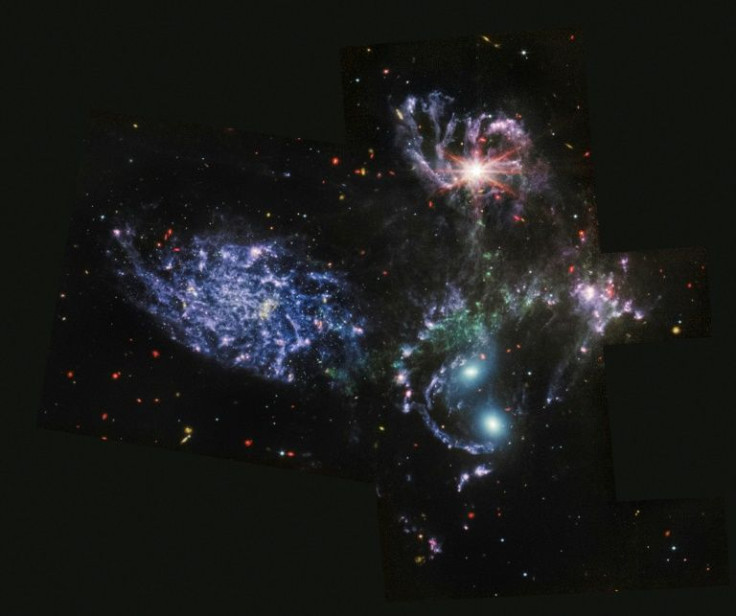NASA Shares Otherworldly Space Music Derived From 4 Space Telescopes [Listen]
KEY POINTS
- NASA shared sonifications of cosmic bodies as captured by different space telescopes
- It's like "how different notes of the musical scale can be played together to create harmonies," NASA said
- The resulting space music is otherworldly, though sometimes rather eerie
You may have thought of what space may look like, but have you ever wondered how it sounds? Wonder no more, because NASA has once again translated some stunning space imagery into music, and the results are otherworldly.
Space telescopes provide incredible views of the cosmos, but it turns out they can be used to create music as well. NASA on Tuesday shared another batch of "cosmic harmonies," or the music resulting from the translations of space data into music.
This time, the space music came from data from four space telescopes: James Webb Space Telescope, Hubble Space Telescope, Spitzer Space Telescope and the Chandra X-Ray Observatory — the latter three being among the observatories under NASA's Great Observatories Program.
"Because different telescopes can detect different types of light, each brings its own pieces of information to whatever is being observed," NASA noted. "This is similar in some ways to how different notes of the musical scale can be played together to create harmonies that are impossible with single notes alone."
In the sonification of R Aquarii, for instance, one can hear the different layers of sound produced from the data as it moves in a clock-like manner starting from the 12 o'clock mark. Beyond the loud bright and chiming sounds, one can also hear a rather eerie, deeper sound underneath, making for a truly otherworldly experience.
We’ve taken light data detected by four of our telescopes—@ChandraXray, @NASAWebb, @NASAHubble, and Spitzer Space Telescope—and turned them into sound. Hear what some galaxies and stars sound like: https://t.co/InaZnfy9RH pic.twitter.com/LaWcvH6uSB
— NASA (@NASA) June 20, 2023
R Aquarii is a system where a white dwarf and red giant orbit each other, NASA explained. The "rising and falling" melodies that resemble the sounds of singing bowls evidently came from the Hubble data, while the outstanding "windy purr" came from Chandra.
NASA also shared the sonification of space telescope data of Stephan's Quintet, which lies some 290 million light-years away from our planet. This is the group of five galaxies, wherein four are close together and one is a bit farther. The visual image came from Webb, Spitzer and Chandra, and this time the sonification begins from the top to the bottom.
The resulting music for Stephan's Quintet sounds quite different from that of R Aquarii. Interestingly, it sounds quite like one is stepping into a completely different world when the fast chiming, windy and squawk-like sounds are all together.
Stephan's Quintet
— Chandra Observatory (@chandraxray) June 20, 2023
Distance from Earth: About 290 million light-years
More at: https://t.co/mIvozVUHTJ pic.twitter.com/xoXMDwvr9L
Lastly, NASA also shared the sonification of Messier 104 (M 104), which is relatively closer than Stephan's Quintet at 28 million light-years away from Earth. M 104 is among the largest galaxies in the Virgo cluster, NASA explained.
"In sonifying these data, we can listen to each type of light either separately or together. Either option begins at the top and scans toward the bottom of the image," NASA explained. "The X-rays from Chandra sound like a synthesizer, Spitzer's infrared data are strings and optical light from Hubble has bell-like tones."
This time, the sonification sounds quite like it came straight out of a scene in a sci-fi flick, especially when the sonified data are combined. Though underneath the whirring sounds also lies majestic-sounding music.
Galaxy M104
— Chandra Observatory (@chandraxray) June 20, 2023
Distance from Earth: About 28 million light-years
More at: https://t.co/mIvozVUHTJ pic.twitter.com/QBjuNoyAuL
This is not the first time that NASA scientists have shared "cosmic harmonies" so people can enjoy space with their ears as well as their eyes.
Previously, for instance, they translated the first Webb images into equally stunning music. They also shared the sounds of the black hole at the center of the Perseus galaxy cluster, which was as fascinating as it was haunting.
These sounds are certainly interesting to listen to, especially since they make space more accessible for everyone to enjoy with a few simple sound clips. In the case of the new cosmic harmonies, it's also a rather interesting display of how data from these powerful telescopes can be combined, not just to provide valuable information, but also to create wonderful space music.

© Copyright IBTimes 2024. All rights reserved.






















